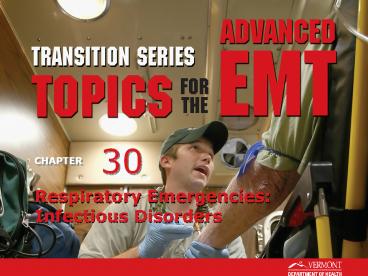Respiratory Emergencies: Infectious Disorders PowerPoint PPT Presentation
1 / 23
Title: Respiratory Emergencies: Infectious Disorders
1
30
Respiratory Emergencies Infectious Disorders
2
Objectives
- Review frequency of infectious respiratory
disorders. - Relate pathophysiology of infectious disorder to
presenting signs and symptoms. - Discuss current treatment standards for patients
with dyspnea from an infectious disorder.
3
Introduction
- This topic deals with disorders that alter normal
gas diffusion in the lungs due to an infectious
pulmonary problem. - As in previous topics, the patient will have
general dyspnea findings, but the history should
help illustrate the cause.
4
Epidemiology
- Lower respiratory infections are a leading cause
of death worldwide. - CDC reports recent outbreaks of pertussis in the
United States. - VRIs are the most common cause of symptomatic
disease among children and adults.
5
Pathophysiology
- Pneumonia
- Bacteria or virus induced
- Lower respiratory lung infection
- Can result in fluid- or pus-filled alveoli
- Diminishes ventilation (V/Q ratio) with resultant
dyspnea and blood gas alterations
6
Pneumonia causes inflammation of the lungs and
causes the alveoli to fill with fluid or pus,
leading to poor gas exchange.
7
Pathophysiology (contd)
- Pertussis
- Whooping cough
- Development of heavy mucus from airway
- Paroxysms of coughing
- Complications include pneumonia, dehydration,
seizures, brain injuries
8
Pathophysiology (contd)
- Viral respiratory infections
- Common VRIs
- Bronchiolitis, colds, flu
- Usually mild and self-limiting
- Can cause upper or lower respiratory infections
- Cause inflammatory response and mucus production
in airway structures
9
Assessment Findings
- General assessment findings
- Common to most patients with dyspnea
- Changes in respiratory rate and breath sounds
- Accessory muscle use
- Tripod positioning and retractions
- Nasal flaring, mouth breathing
- Changes in pulse oximetry and vitals
- Skin change and mental status changes
10
Assessment Findings (contd)
- Additional findings with pneumonia
- Malaise and decreased appetite
- Cough (possibly productive)
- General dyspnea findings
- Pleuritic chest pain
- Diaphoresis
- Possible fever
11
Assessment Findings (contd)
- Additional findings with pertussis
- History of URI
- Runny nose, low-grade fever
- Episodes of coughing followed by whooping sound
- Fatigue from coughing
12
Assessment Findings (contd)
- Additional findings with a VRI
- Nasal congestion
- Irritated or painful throat
- Mild dyspnea
- Fever
- Malaise, headache, body ache
- Poor feeding in infants
13
Emergency Medical Care
- Ensure airway adequacy.
- Provide oxygen based on ventilatory need.
- NRB mask at 15 lpm with adequate breathing
- PPV with 15 lpm oxygen with inadequate breathing
14
Emergency Medical Care (contd)
- Administer inhaled bronchodilator PRN.
- Keep patient sitting upright if possible.
- Provide rapid transport to the ED.
15
Case Study
- You are called to an elder care facility for a
patient with an altered mental status. Upon your
arrival, you are escorted to a patient's room
where an elderly male patient lies in bed,
seemingly asleep.
16
Case Study (contd)
- Scene Size-Up
- Scene is safe, standard precautions taken.
- Patient is 91 years old, about 145 lbs.
- Entry and egress from room is unobstructed.
- NOI appears to be altered mental status.
- No additional resources needed.
17
Case Study (contd)
- Primary Assessment Findings
- Patient moans to loud verbal stimuli.
- Airway patent and self-maintained.
- Breathing adequate but tachypneic.
- Central and peripheral pulses present.
- Skin is noted to be diaphoretic.
18
Case Study (contd)
- Medical History
- Patient has history of pancreatic cancer
- Medications
- Primarily comfort medications
- Allergies
- Demerol
19
Case Study (contd)
- Pertinent Secondary Assessment Findings
- Pupils equal and reactive, membranes dry.
- Airway patent, breathing rapid with markedly
diminished breath sounds over left lung some
crackles and rhonchi discernible. - Peripheral perfusion intact, heart rate fast and
regular.
20
Case Study (contd)
- Pertinent Secondary Assessment Findings
(continued) - Pulse ox 92 on room air, B/P WNL.
- Skin diaphoretic and warm.
- Patient has not eaten for a day and a half.
- Fever 101.5 F
21
Case Study (contd)
- What pathologic change is causing the abnormal
breath sounds? - What respiratory condition does this patient
likely have? - What would be three assessment findings that
could confirm your suspicion?
22
Case Study (contd)
- Care provided
- Patient placed on high-flow oxygen.
- Placed in a semi-Fowler position on wheeled cot.
- Transport initiated to ED.
23
Summary
- With infectious disorders, many times the
presentation will be the same despite a varied
etiologic background. - Fortunately, treatment of most all infectious
diseases is similar enough that if the exact
cause is not known, the treatment will still be
appropriate.

